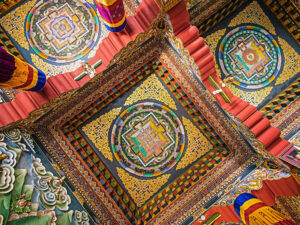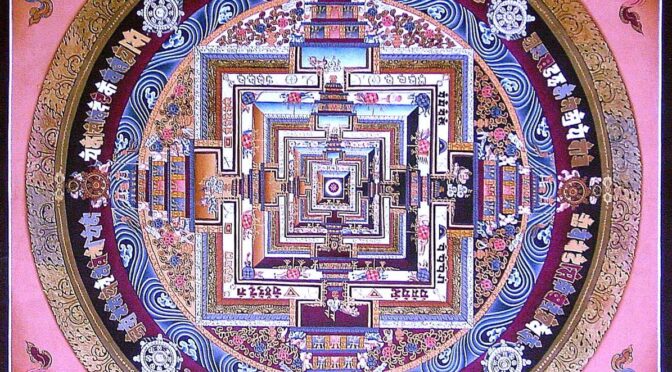We all love mandalas and when we draw one it essentially becomes us. Mandalas have been used in many ancient cultures as a process of connecting with the divine. The most common mandalas are drawn with repeating shapes and symbols while other mandalas hold imagery and each image is a representation of something else. No matter what the mandala contains it is used as a form of meditation, which also a form of connecting with the divine source.
In this article, we are going to take a look at the Tibetan Kalachakra mandala, otherwise known as, The wheel of time. This mandala is the most sacred to the Tibetans as it takes everything into account such as, the human mind and body, the whole external aspect – as well as cosmic and astrological. The Tibetans believe that it is possible to achieve enlightenment in this lifetime if one observes studies and then later produces the mandala.
The Tibetan culture firmly believes in the healing power of this mandala. “We firmly believe in its power to reduce conflict and we believe its capable of creating peace, peace of the spirit and therefore of the mind.” – Tenin Gyatso, the fourteenth Dalai Lama, 1993
When I first came across this intricate mandala it was because I wanted to get ideas for a mandala that had a similar shape. Little did I know, I was about to be let into a whole new world of exploring my mind, body, spirit.

The Kalachakra is known as a ‘divine’ palace, with five levels which are represented by 5 squares imposed onto one another. Within this “divine palace” there are 722 deities and right at its center is Buddha, sitting on a lotus flower.
First level: The body mandala; This level is at the bottom of the Kalachakra, and holds a total of 536 deities. This mandala is a representation of the god and goddesses, animals and geometric shapes that make up the universe. Within the firs square there is another which holds 360 deities which correspond with the 360 days of the Tibetan lunar year.
Second Level: The Speech mandala. This level refers to the virtues of Buddha’s words and his teachings, holding 116 deities. The deities are represented by ‘seed syllables’ which is said to be pure sound that allows the god or goddess to become visible within the disciples mind. Many mantras are also said to be made up of ‘seed syllables’. Its foundation walls are made of five coloured bands – white, yellow, red, black and green. These are also representations of the five faculities that make it possible to access knowledge; wisdom, concentration, attention, effort and trust.
Third level: The Mind Mandala. The structure of this level has not been changed except that it only holds 70 deities and 3 colour bands. Within this level there are fans made of yak hair and this is said to be a representation of alleviating the burns of ignorance and the mirrors that reflect emptiness .The four noble truths are represented by a half moon on each of the four doors . The three bands of colour, black, red and white represent the three paths of Buddhism.
Fourth level: The pristine consciousness mandala. This mandala is seen as being hollowed out by the ‘Great Bliss’ Mandala. But is in fact marked by two blue lines and within the lines are a chain of vajras, (Tibetan thunderbolt) which represent the indestructibility of the awakened mind. There are also sixteen black pillars within this square that represent the sixteen different categories of emptiness. It said the on eight of the pillars rests a lotus flower and upon the flower rests a pair of embracing deities in the same way Buddha embraced the teachings of this mandala.
Fifth level: The Great Bliss mandala – Entering happiness. This is the last of the squares and within this square is a lotus flower with eight petals, in the center of the lotus sits Buddha. In the corners of this square there are dots that represent the qualities of the the body, the word, the mind, and the consciousness of the Kalachakra (Buddha). Buddha is painted in blue and is accompanied by his consort, Vishvamatta. It is said that another two Buddha’s and their consorts reside within the lotus and that their intimate embrace is symbolizes the Awakening of compassion, union and finally absolute wisdom.
Made traditionally with colored powders, monks train for a minimum of three years before being allowed to construct this intricately decorated ‘palace of the mind’. As you can see the Tibetan mandala is a lot more complicated than originally thought and its not as easy as a coloring in mandala book! It holds, wisdom, truth and a path of enlightenment to anyone who chooses to study and embrace all that it encompasses.
Sources:
Book; Tibetan Mandala by Sylvie Crossman and Jean-Pierre Barou.
www.thangka.de/Gallery-2/Wrathful/5-15/Kalachak.htm

